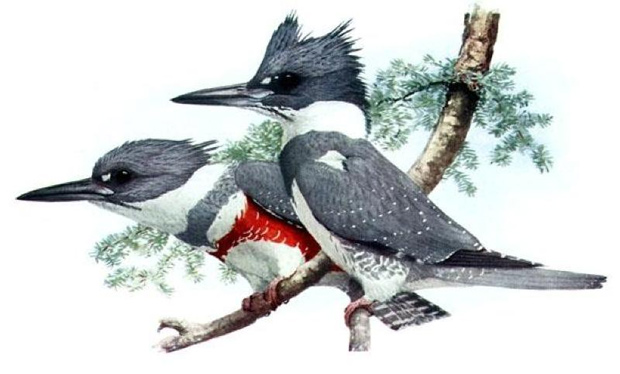
Seasonal movement, or lack thereof—kingfishers that reside in Yosemite will remain in the area throughout the entire year, as many of us would want to do, as long as they have access to open water for finding food such as fish, aquatic invertebrates (insects, crawfish, etc.) and small vertebrates (amphibians, small mammals and small birds) and a dirt bank of sandy, clay substrate for their shelter or nest cavity.
Plumage—male and female kingfishers reverse roles when it comes to appearance. Female belted kingfishers are the bright, flashy ones with blue and rufous (rust-colored red) breast bands. Males look relatively unimpressive by comparison with a solid white breast. Normally males utilize their showy plumage to attract a mate;however, in this case, females are attracted to the quality of the breeding territory that the male has chosen. The most attractive tracts of land are usually about 1000 yards along a stretch of stream or river that has numerous observation perches for feeding and a substantial exposed substrate along the banks.
Nesting—perhaps the most unique behavior of our belted kingfisher is nest construction. These excavators seek out exposed river or road banks with a sandy, clay substrate where they begin burrowing about 1-3 feet below the top of the bank. Both males and females rotate between digging a 3-4 inch diameter tunnel with their beaks while the other stands guard just outside the nest site on a nearby perch. These tunnels can be anywhere from three to upwards of fifteen feet in length with a cavity at the end measuring about a foot wide by six inches tall. This is a stretch from our images of a grass constructed nest, especially when the only material the kingfisher seeks is soil.
Nestlings—once hatched, after having been incubated by both mom and dad, young belted kingfishers are fed by both parents as well. Most notably, nestlings have a unique way of developing plumage. Initially, young are born without feathers, but within a week will develop all their feathers at once, which are contained in individual sheathes. Normally, birds shed these sheaths shortly after developing feathers, giving them a disheveled appearance. Instead, kingfishers hold onto their un-open feathers for up to two weeks, making them look like tiny porcupines. All of their feathers will open at once and their plumage will be similar to an adult within the first three weeks of life.
Such details of Yosemite National Park are awaiting your discovery—enjoy setting off on a trail to seek your unique niche in this diverse, intriguing national park that is here for you to explore and protect.
